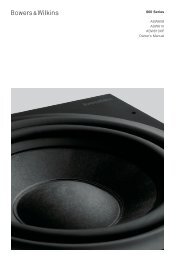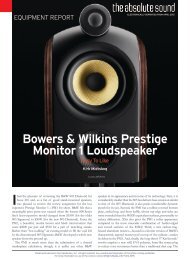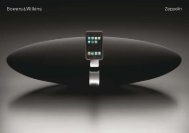Panorama Integrated A/V Sound System Owner's Manual
Panorama Integrated A/V Sound System Owner's Manual
Panorama Integrated A/V Sound System Owner's Manual
Create successful ePaper yourself
Turn your PDF publications into a flip-book with our unique Google optimized e-Paper software.
cover, stand <strong>Panorama</strong> upright and gently push the<br />
cover downward and away. Figure 2 illustrates removal<br />
of the cover. Once the cover is removed, <strong>Panorama</strong><br />
must be turned upside-down to gain access to the<br />
connection sockets. Ensure that the surface on which<br />
<strong>Panorama</strong> is then placed will not damage its top<br />
surface finish.<br />
In addition to the mains and signal input sockets, a<br />
subwoofer output socket and a service socket are also<br />
present. Use of the subwoofer socket is covered below.<br />
The service socket is not intended for consumer use.<br />
Figures 3a and 3b illustrates and identifies <strong>Panorama</strong><br />
connection sockets.<br />
<strong>Panorama</strong> incorporates a cable-dressing channel that<br />
enables the input and subwoofer output cables to be<br />
collected together and to exit the unit from the same<br />
location adjacent to the mains power cable. To use the<br />
cable-dressing channel, collect the cables together and<br />
insert them in the open channel. Rotate the lever to<br />
close the channel and retain the cables. Figure 4<br />
illustrates use of the cable-dressing channel.<br />
2.2 Connecting a Subwoofer<br />
An active subwoofer can be connected to <strong>Panorama</strong>. A<br />
subwoofer can enhance the <strong>Panorama</strong> experience by<br />
providing extra impact on movie soundtracks and<br />
extending bass response on stereo music programme.<br />
The subwoofer is connected via <strong>Panorama</strong>’s subwoofer<br />
output socket. Remove the connection cover as<br />
described above and identify the subwoofer output<br />
socket. Connect one end of an RCA phono cable to the<br />
socket and the other end of the cable to the<br />
subwoofer’s input socket.<br />
Ensure that the subwoofer is switched on. As <strong>Panorama</strong><br />
handles the appropriate low-pass filtering on its<br />
subwoofer output, the subwoofer’s internal low pass<br />
filter should be set to its maximum or switched off.<br />
Initially set the subwoofer’s volume level control to<br />
between half and three-quarters maximum then fine<br />
control its volume via the <strong>Panorama</strong> subwoofer level<br />
setup menu (See Paragraph 4.1).<br />
2.3 <strong>Panorama</strong> Location and Mounting<br />
The home theatre surround performance achieved by<br />
<strong>Panorama</strong> will be optimized if it is located in the room<br />
approximately symmetrically between two soundreflective<br />
walls. Figure 5 illustrates two possible room<br />
layouts. <strong>Panorama</strong> can be either mounted on table<br />
centrally in front of the home theater TV or be wall<br />
mounted using the supplied bracket centrally above or<br />
below the TV.<br />
Note: A <strong>Panorama</strong> setup function enables selection of<br />
bass equalisation characteristics appriopriate to either<br />
wall or table locations. See Section 4.1.<br />
If <strong>Panorama</strong> is to be table mounted the bracket is not<br />
required. <strong>Panorama</strong> may be either placed directly on the<br />
table or raised using one of the sets of feet supplied. To<br />
fit the feet carefully turn <strong>Panorama</strong> upside-down on the<br />
surface and screw them into the tapped holes. Figure 6<br />
illustrates fitting the feet.<br />
If <strong>Panorama</strong> is to be wall mounted, the bracket screw<br />
hole positions on the wall must first be established. Use<br />
a spirit level to ensure the bracket is level before marking<br />
the hole positions. Drill and plug the wall for appropriate<br />
screws. A second person to assist with marking holes<br />
and lifting <strong>Panorama</strong> is recommended. <strong>Panorama</strong>’s rear<br />
cover must be removed when it is wall mounted.<br />
Use wall plugs that are appropriate for the type of wall<br />
construction and ensure that wall, plugs and screws are<br />
capable of reliably supporting <strong>Panorama</strong>’s weight<br />
(10.6kg). If you have any doubt over your ability to mount<br />
the bracket securely to the wall you should engage<br />
specialist help. Once the bracket has been secured to the<br />
wall, <strong>Panorama</strong> can be lifted into the bracket where it is<br />
secured by lugs on its rear face engaging with key-hole<br />
slots. Figures 7a to 7e illustrates use of the wall bracket.<br />
3. USING PANORAMA<br />
<strong>Panorama</strong> is simple to operate with all commonly used<br />
functions on both its front panel and remote control<br />
handset.<br />
Note: Universal or “learning” remote handsets may also<br />
be used to control <strong>Panorama</strong>. If <strong>Panorama</strong> remote<br />
control codes are required for handset programming<br />
they can be found in the Support section of the B&W<br />
web site at www.bowers-wilkins.co.uk.<br />
3.1 Front Panel Controls<br />
<strong>Panorama</strong> front panel controls functions consist of the<br />
following:<br />
G input: Press to switch on <strong>Panorama</strong> and then press<br />
to select each input in turn. Press and hold for three<br />
seconds to switch off <strong>Panorama</strong>.<br />
mode: Selects <strong>Panorama</strong> programme decode modes.<br />
See Figure 10<br />
– v +: Adjusts <strong>Panorama</strong> volume.<br />
3.2 Remote Handset<br />
Before the remote handset is first used the clear plastic<br />
insulating tab that prevents its battery from draining<br />
must be removed. Follow the procedure illustrated in<br />
Figure 8 and described below and to remove the<br />
insulating tab.<br />
• Rotate the battery cover anticlockwise 1/8 full turn<br />
and remove it.<br />
• Release the battery by pressing down on the edge<br />
opposite the metal spring.<br />
• Remove and discard the insulator.<br />
• Replace the battery, first locating one side under<br />
the small lugs opposite the metal spring.<br />
• Replace the cover.<br />
Figure 9 illustrates the remote handset and the following<br />
paragraph describes its functions.<br />
G Switches <strong>Panorama</strong> on and off.<br />
+ Raises <strong>Panorama</strong> volume.<br />
Mutes and un-mutes <strong>Panorama</strong>.<br />
voice Switches <strong>Panorama</strong> to Voice mode. Voice<br />
mode emphasizes the vocal content of movie<br />
sound tracks and can be useful for late night<br />
use when movie sound effects and music<br />
might otherwise disturb others.<br />
Pressing and holding the voice button for five<br />
seconds or more switches <strong>Panorama</strong> into<br />
7











